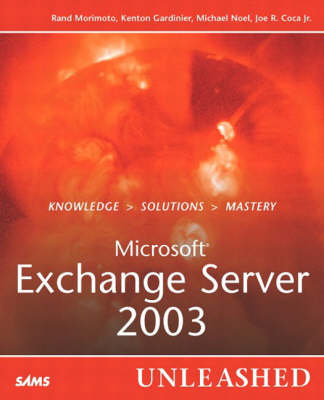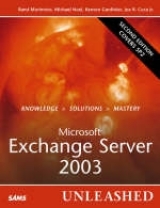
Microsoft Exchange Server 2003 Unleashed
Sams Publishing (Verlag)
978-0-672-32581-6 (ISBN)
- Titel erscheint in neuer Auflage
- Artikel merken
The most extensive Exchange 2003 reference found on the market today from one of the world's leading Microsoft server experts, Rand Morimoto. Written from the ground up exclusively for Exchange 2003--not a revision of an Exchange 2000 book. Based on the author's experience implementing Exchange 2003 in heavy-use corporate environments since Beta release 1. Contains hard-to-find intermediate to advanced coverage far beyond the competition's typical installation and set-up how-to's including planning, migration, security, disaster recovery, and vast troubleshooting tips. A complete reference targeted at intermediate to advanced users for help in managing the complicated and business-critical matters of e-mail, message databases, and ever-increasing mobile and remote system access.
Rand H. Morimoto, MCSE Rand Morimoto has been in the computer industry for over 25 years and has authored, co-authored, or been a contributing writer for over a dozen books on Windows 2003, Security, Exchange 2000, BizTalk Server, and Remote and Mobile Computing. Rand is the president of Convergent Computing, an IT-consulting firm in the San Francisco Bay area that has been one of the key early adopter program partners with Microsoft, implementing beta versions of Microsoft Exchange Server 2003, SharePoint 2003, and Windows Server 2003 in production environments over 2 years before the product releases. Besides speaking at over 50 conferences and conventions around the world in the past year on tips, tricks, and best practices on planning, migrating, and implementing Exchange 2003, Rand is also a special advisor to the White House on cyber-security and cyber-terrorism. Kenton Gardinier, MCSE, CISSP, MCSA Kenton Gardinier is a senior consultant with Convergent Computing. He has designed and implemented technical and business-driven solutions for organizations of all sizes around the world for over 10 years. He has also led early adopter engagements, implementing products such as Windows Server 2003, Exchange Server 2003, and SharePoint Portal Server 2003 prior to the products' release for numerous organizations. Kenton is an internationally recognized author and public speaker. His speaking engagements include various industry-renowned conferences and Web casts. He has authored, co-authored, and contributed to several books on Windows, Exchange, security, performance tuning, administration, and systems management. Kenton has also written several magazine columns specializing in various technologies. He holds many certifications, including MCSE, CISSP, and MCSA. Michael Noel, MCSE+I, MCSA Michael Noel has been in the computer industry for over 10 years and has been working with the latest in Windows and Exchange technologies since the early versions of the software. Michael is the co-author of Windows Server 2003 Unleashed by Sams Publishing and has also been a contributing writer of books on Windows 2000, Exchange 2000, and Microsoft Operations Manager. Currently a senior consultant at Convergent Computing in the San Francisco Bay area, Michael has designed and implemented numerous large-scale technical projects with worldwide Active Directory and Exchange migrations, SharePoint Document Management and Portal Solutions, and high-availability solutions. Michael's experience in the area of real-world design and deployment and his level of involvement in Windows and Exchange server technologies from the beta stages supports his credentials in the field. Joe R. Coca Jr., MCSE Joe Coca has been in the computer industry for over eight years and has been a contributing writer of several books, such as Windows Server 2003 Unleashed and Windows 2000 Design and Migration. In addition to writing, Joe has also been a guest speaker with the Enterprise Networking Association Conference and the president of a large user group in Silicon Valley and the San Francisco Bay area. As a consultant with Convergent Computing, Joe has designed and implemented various large Windows Server 2003 Active Directory and Exchange 2000 and 2003 environments, including several worldwide migrations from previous platforms to Microsoft Windows and Exchange Server.
(NOTE: Each chapter concludes with a Summary and Best Practices.)
Introduction.
I. MICROSOFT EXCHANGE SERVER 2003 OVERVIEW.
1. Exchange Server 2003 Technology Primer.
Using Exchange 2003 As an Email and Calendaring Solution. Taking Advantage of Active Directory in Exchange. Leveraging the Exchange 2003 As a Web Access Solution. Expanding into the New Wireless and Mobility Technologies. Choosing the Right Time to Migrate to Exchange 2003. Understanding the Two Versions of Exchange 2003. Understanding How Improvements in Windows 2003 Enhance Exchange 2003. Reliability Enhancements in Exchange Server 2003. Expanding on Manageability and Administration Benefits of Exchange 2003. Improvements in Exchange 2003 Security. Leveraging Mobility in Exchange 2003. Performance Improvements in Exchange 2003. Solidifying Core Technologies for Exchange 2003.
2. Planning, Prototyping, Migrating, and Deploying Exchange Server 2003.
Initiation, Planning, Testing, and Implementation: The Four Phases to the Upgrade. Initiation Phase: Defining the Scope and Goals. Initiation Phase: Creating the Statement of Work. Planning Phase: Discovery. Planning Phase: Creating the Design Document. Creating the Migration Document. The Prototype Phase. The Testing Phase: Validating the Plan to a Limited Number of Users. The Implementation.
3. Installing Exchange Server 2003.
Preparing for Implementation of Exchange 2003. Preparing to Install Exchange 2003. Conducting Preinstallation Checks on Exchange 2003. Performing an Interactive Installation of Exchange Server 2003. Performing a Scripted Installation of Exchange Server 2003. Completing the Installation of Exchange 2003. Performing Postinstallation Configurations. Configuring Additional Server Services. Testing the Exchange 2003 Installation.
II. MICROSOFT EXCHANGE SERVER 2003 MESSAGING.
4. Exchange Server 2003 Design Concepts.
Formulating a Successful Design Strategy. Getting the Most Out of Exchange Server 2003 Functionality. Active Directory Design Concepts for Exchange Server 2003. Determining Exchange Server 2003 Placement. Configuring Exchange Server 2003 for Maximum Performance and Reliability. Securing and Maintaining an Exchange Server 2003 Implementation.
5. Designing an Enterprise Exchange Server 2003 Environment.
Designing for Small Organizations-Company123. Designing for Midsize Organizations-OrganizationY. Designing for Large Organizations-CompanyABC. Designing Active Directory for Exchange Server 2003. Determining Hardware and Software Components. Designing Exchange Infrastructure. Integrating Client Access into Exchange Server 2003 Design. Summarizing Design Examples.
6. Integrating Exchange Server 2003 in a Non-Windows Environment.
Synchronizing Directory Information with Microsoft Identity Integration Services (MIIS) 2003. Synchronizing Exchange Server 2003 with Novell eDirectory. Managing Identity Information Between LDAP Directories and Exchange Server 2003. Using Services for Unix to Integrate Unix Environments with Exchange Server 2003.
III. MICROSOFT NETWORKING SERVICES' IMPACT ON EXCHANGE.
7. Domain Name System Impact on Exchange Server 2003.
Domain Name Service Defined. Types of DNS Servers. Examining DNS Components. Using DNS to Route SMTP Mail in Exchange Server 2003. Understanding DNS Requirements for Exchange Server 2003. Configuring DNS to Support Exchange Servers. Troubleshooting DNS Problems.
8. Global Catalog and Domain Controller Placement.
Active Directory Structure. Examining the Role of Domain Controllers in AD. Defining the Global Catalog. Exploring DSAccess, DSProxy, and the Categorizer. Understanding AD Functionality Modes and Their Relationship to Exchange Groups.
9. Configuring Routing and Remote Access for Mobile Users.
Windows Server 2003 Routing and Remote Access Features and Services. Configuring Routing and Remote Access Service Architecture. Examining Virtual Private Networks. Outlining Authentication Options to an RRAS System. Examining VPN Protocols. Choosing Between PPTP and L2TP/IPSec. Installing and Configuring Routing and Remote Access. Configuring Remote Access Clients. Using RRAS Tools and Utilities. Remote Access Scenarios.
10. Outlook Web Access 2003.
Understanding OWA and the Exchange Virtual Server. Designing an Exchange Front-end/Back-end OWA Architecture. Configuring Front-end and Back-end Servers. Upgrading Existing Exchange 2000 Front-end OWA Servers.
IV. SECURING MICROSOFT EXCHANGE SERVER 2003 ENVIRONMENT.
11. Client-Level Security.
Tips and Tricks for Hardening Windows. Exchange Server 2003 Client-Level Security Enhancements. Securing Outlook 2003. Protecting Against Spam. Securing Outlook Web Access. Using Digital Signatures and Encryption.
12. Server-Level Security.
Microsoft's Trustworthy Computing Initiative. Assessing Your Risks. Designing a Secure Messaging Environment. Exchange Server-side Security Improvements. Tips, Tricks, and Best Practices for Hardening Windows Server 2003. Securing by Functional Roles of the Server. Standardizing Exchange Server 2003 Servers. Protecting Exchange Server 2003 from Viruses. Combating Spam.
13. Transport-Level Security.
The Onion Approach. Using Public Key Infrastructure with Exchange Server 2003. Supporting S/MIME. Protecting Communications with IP Security. Configuring IPSec. Locking Down SMTP. Securing Routing Group Connectors. Securing Other Exchange-Supported Protocols. Protecting Client-to-Front-end-Server Communications. Locking Down Front-end and Back-end Server Communications.
V. MIGRATING TO MICROSOFT EXCHANGE SERVER 2003.
14. Migrating from NT4 to Windows Server 2003.
Defining the Migration Process. Upgrading a Single Member Server. Upgrading an NT 4.0 Domain Structure to Active Directory via the In-Place. Upgrade Process. Migrating Existing NT4 Domains to a New Windows Server 2003 Forest. Understanding and Using the Microsoft Active Directory Migration Tool 2.0 (ADMT v2). Migrating Accounts Using the Active Directory Migration Tool.
15. Migrating from Exchange v5.5 to Exchange Server 2003.
Understanding Exchange 5.5 Migration Options and Strategies. Comparing Exchange 5.5 and Exchange Server 2003 Environments. Prerequisites for Migrating to Exchange Server 2003. Structuring the Migration for Best Results. Preparing the Active Directory Forest and Domain for Exchange Server 2003. Installing and Configuring the Active Directory Connector. Installing the First Exchange Server 2003 System in an Exchange 5.5 Site. Understanding Exchange Server 2003 Mailbox-Migration Methods. Migrating Exchange 5.5 Public Folders to Exchange Server 2003. Migrating Exchange 5.5 Connectors and Services to Exchange Server 2003. Completing the Migration to Exchange Server 2003.
16. Migrating from Exchange 2000 to Exchange Server 2003.
Outlining Migration Options from Exchange 2000 to Exchange Server 2003. Deploying a Prototype Lab for the Exchange Server 2003 Migration Process. Migrating to Exchange Server 2003 Using the In-Place Upgrade Approach. Migrating to Exchange Server 2003 Using the Move Mailbox Method.
17. Compatibility Testing for Exchange Server 2003.
The Importance of Compatibility Testing. Preparing for Compatibility Testing. Researching Products and Applications. Verifying Compatibility with Vendors. Lab-Testing Existing Applications. Documenting the Results of the Compatibility Testing. Determining Whether a Prototype Phase Is Required.
VI. MICROSOFT EXCHANGE SERVER 2003 ADMINISTRATION AND MANAGEMENT.
18. Exchange Server 2003 Mailbox, Distribution Group, and Administrative Group Administration.
Exchange Administration and the Delegation Wizard. Managing Mailboxes and Message Settings in Exchange Server 2003. Managing New Mailbox Features. Moving Exchange User Mailboxes. Creating and Managing Exchange Contacts. Planning and Creating Distribution Groups. Creating and Managing Exchange Server 2003 Administrative Groups. Creating and Managing Routing Groups. Using Recipient Policies. Administering Recipient Update Services. Using the Mailbox Recovery Center Tool. Using the Mailbox Manager Utility.
19. Exchange Server 2003 Management and Maintenance Practices.
Managing Exchange Server 2003. Auditing the Environment. Managing Exchange Server 2003 Remotely. Maintenance Tools for Exchange Server 2003. Best Practices for Performing Database Maintenance. Prioritizing and Scheduling Maintenance Best Practices. Post-Maintenance Procedures. Reducing Management and Maintenance Efforts.
20. Documenting an Exchange Server 2003 Environment.
Planning Exchange Server 2003 Documentation. Benefits of Documentation. Design and Planning Documentation. Developing the Migration Documentation. Exchange Server 2003 Environment Documentation. Administration and Maintenance Documentation. Disaster Recovery Documentation. Performance Documentation. Security Documentation. Training Documentation.
21. Using Terminal Services to Manage Exchange Servers.
Terminal Services Modes of Operation. Using Terminal Services on Pocket Devices. Using Exchange System Manager to Remotely Manage Exchange Server 2003.
VII. NEW MOBILITY FUNCTIONALITY IN MICROSOFT EXCHANGE SERVER 2003.
22. Designing Mobility in Microsoft Exchange Server 2003.
Accessing Outlook Using VPN Connectivity. Leveraging Exchange ActiveSync for PDA Mobile Communications. Using Outlook Mobile Access for Browser-Based Devices. Designing the Appropriate Use of Exchange 2003 Mobility Capabilities. Using Exchange Mobility for the Mobile Executive. Replacing Laptops with Mobile Pocket Devices. Leveraging a Low-Cost PDA Instead of an Expensive Tablet.
23. Implementing Mobile Synchronization in Exchange Server 2003.
Preparing for Mobility in an Exchange 2003 Environment. Installing an Exchange Server 2003 Server for Mobile Access. Migrating from Microsoft Mobile Information Server. Configuring Mobile Exchange Features.
24. Configuring Client Systems for Mobility.
Identifying Mobile Devices to Be Supported. Supporting the Pocket PC 2002 Synchronization with Microsoft Exchange 2003. Supporting Pocket PC 2003 Synchronization with Exchange 2003. Using the Pocket PC 2002 and Pocket PC 2003. Working with Smartphones. Establishing a Link from a Mobile Phone to Exchange 2003. Using Outlook Mobile Access to Exchange Server 2003.
VIII. CLIENT ACCESS TO MICROSOFT EXCHANGE SERVER 2003.
25. Getting the Most Out of the Microsoft Outlook Client.
What's Common Across All Versions of Outlook. What's New in Outlook 2003. Customizing the End User Experience. Security Enhancements in Outlook 2003. Understanding RPC over HTTP. Using Outlook 2003 Collaboratively. Using Outlook Cached Mode for Remote Connectivity.
26. Everything You Need to Know About Outlook Web Access Client.
Understanding Microsoft's Direction on OWA. Using the Basics of OWA/2003. What's New in the OWA Client (Since Exchange 2000). Getting to Know the Look and Feel of OWA/2003. Using OWA Mail Features. Taking Advantage of Advanced OWA Features. Customizing OWA Options. Using the Calendar in OWA. Gaining Functionality from the Meeting Invitation Functions. Using Tasks in OWA. Using Contacts in OWA. Understanding OWA Security Features. Tips for OWA Users with Slow Access.
27. Outlook for Non-Windows Systems.
Understanding Non-Windows-Based Mail Client Options. Outlook for Macintosh. Outlook Express. Configuring and Implementing Entourage X for Mac. Terminal Services Client for Mac. Understanding Other Non-Windows Client Access Methods.
IX. CLIENT ADMINISTRATION AND MANAGEMENT.
28. Deploying the Client for Microsoft Exchange.
Understanding Deployment Options. Planning Considerations and Best Practices. Preparing the Deployment. Installing the Exchange Client. Pushing Client Software with Windows 2003 Group Policies. Deploying with Microsoft Systems Management Server. Managing Post-Deployment Tasks.
29. Group Policy Management for Exchange Clients.
Understanding Group Policy Management with Outlook. Baseline Administration for Group Policy Deployment. Outlook Client Group Policies. Administering Outlook Through Group Policy. Updates and Patch Management with Group Policies.
X. FAULT TOLERANCE AND OPTIMIZATION TECHNOLOGIES.
30. System-level Fault Tolerance (Clustering/Network Load Balancing).
Clustering and Load Balancing with Exchange 2003 Server. Clusters and Load Balancing Requirements. Implementing Fault-Tolerant Exchange Systems. Installing Exchange Server 2003 Clusters. Managing Exchange 2003 Clusters. Outlook Web Access Front-end Server and Load Balancing Clusters.
31. Backing Up the Exchange Server 2003 Environment.
Using Backup to Solve Department Challenges. Maintaining Documentation on the Exchange Environment. Developing a Backup Strategy. Backing Up the Windows Server 2003 and Exchange Server 2003. Using the Windows Backup Utility (Ntbackup.exe). Backing Up Specific Windows Services. Managing Media in a Structured Backup Strategy.
32. Recovering from a Disaster.
Identifying the Extent of the Problem. What to Do Before Performing Any Server-Recovery Process. Preparing for a More Easily Recoverable Environment. Recovering from a Site Failure. Recovering from a Disk Failure. Recovering from a Boot Failure. Recovering from a Complete Server Failure. Recovering Exchange Application and Exchange Data. Recovering from Database Corruption. Using the Recovery Storage Group in Exchange Server 2003. Recovering Internet Information Services. Recovering the Cluster Service. Recovering Windows Server 2003 Domain Controllers. Recovering Active Directory.
33. Capacity Analysis and Performance Optimization.
Examining Exchange Server 2003 Performance Improvements. Analyzing Capacity. Monitoring Exchange Server 2003. Analyzing and Monitoring Core Elements. Properly Sizing Exchange Server 2003. Optimizing Exchange Through Ongoing Maintenance. Monitoring Exchange with Microsoft Operations Manager.
Index.
| Erscheint lt. Verlag | 8.1.2004 |
|---|---|
| Verlagsort | Indianapolis |
| Sprache | englisch |
| Maße | 188 x 230 mm |
| Gewicht | 1750 g |
| Themenwelt | Informatik ► Netzwerke ► Mail Server |
| ISBN-10 | 0-672-32581-0 / 0672325810 |
| ISBN-13 | 978-0-672-32581-6 / 9780672325816 |
| Zustand | Neuware |
| Informationen gemäß Produktsicherheitsverordnung (GPSR) | |
| Haben Sie eine Frage zum Produkt? |
aus dem Bereich


